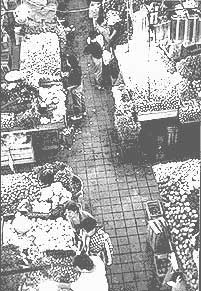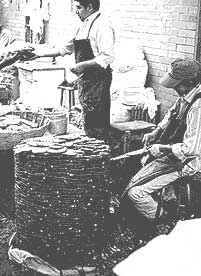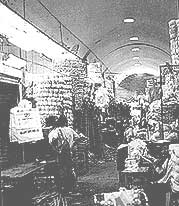Connected to a functioning Internet, above you should see the current Google Maps presentation of the huge Mercado de La Merced, the Merced Market, in which our "One Day" takes place. Keep in mind that our One Day essay was written around 1994, so some features have changed. However, here are some orientation points:
- The orange "M" in the picture's center marks the Merced Metro Station
- The big N/S-running street, "1" is the "Anillo de Circunvalación"
- The big street entering from the left, "1A," is Pino Suárez
- The large, pinkish area consists of a huge maze of small stalls selling diverse items
- North of the Merced is the candy zone, Mercado de Dulces
- On the map zoom in (+) for more detail, (-) for wider view
- Zoom out (-) to see the Mercado Sonora, to the south, or bottom
- Zoom in (+) and blue circles appear designating certain individual establishments; clicking on one opens a small window with more information, and a "View larger map" option, where you can go into street view (little yellow man at lower right) to see recent street scenes
The above map shows that the Merced is a complex of market buildings, not just one. A subway entrance opens in a main market area.

Typical view inside the main market area; copyright free image courtesy of "Thelmadatter" made available through Wikimedia Commons.
As seen above, the interior of the Merced's main building consists of aisle after aisle separating unwalled, room-size establishments arranged next to one another. Each of the Merced's hundreds of stalls specialize in something. In the above picture we're seeing a transition zone between citrus fruits and fresh chilies into tomatoes; but sometimes other items sneak in, so we're not considering a fixed rule. Still, when you pass through the fresh pepper zone, your eyes water; walk through the garlic area and your head swims.

Lane in the flower market, Mercado de Flores; copyright free image courtesy of "Comisión Mexicana de Filmaciones" made available through Wikimedia Commons.

Iglesia de Santo Tomás de la Palma opposite the Merced flower market; copyright free image courtesy of "ProtoplasmaKid" made available through Wikimedia Commons.
Above, you see a lane in the Flower Market just up the street (north) from the Merced proper. You can bet that anyone in that area walks through a moist bouquet of aromas that almost knocks you off your feet. The colors and variety of floral designs are as overwhelming as the odors. Across the street from the flower market stands the Iglesia de Santo Tomás de la Palma, shown at the right, a dignified, scrupulously clean little church with a spacious courtyard paved in stone, completely enclosed by a high stone fence. When services there require flowers, the Flower Market could not be more convenient.

Cutting spines from nopal cactus joints in a nopal zone; copyright free image courtesy of "Thelmadatter" made available through Wikimedia Commons.
Yet another zone in the Merced deals with almost nothing but nopal cactus pads, where a critical task each day is to cut away spines. Normally nopal cactus's spines are small and few, but usually every bump on the pad's faces reserves the right to produce at least a few tiny, almost invisible ones, so all the bumps need to be sliced off. In Mexico's arid uplands sometimes you see whole fields of nopal cactus being grown for food.

Lane in the flower market, Mercado de Flores; public domain image courtesy of "Umarina" made available through Wikimedia Commons.
Often sales of all kinds of items sprawl onto sidewalks and into any open area in the vicinity, as seen at the right, the density of selling spots depending on how serious the police are at the moment dealing with informal sales.
Finally, don't forget to look for true down-home cooking, Mexican style:

One of several eating areas, or comedores, in the Merced; copyright free image courtesy of "ProtoplasmaKid" made available through Wikimedia Commons.